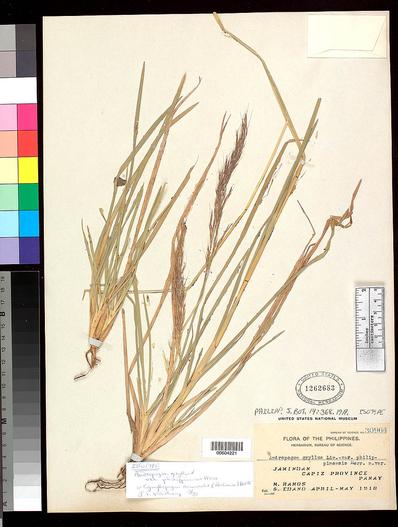Silver Beard Grass
(Chrysopogon nemoralis)
Silver Beard Grass (Chrysopogon nemoralis)
/
/

filibot.web
CC BY-SA 2.0
Image By:
filibot.web
Recorded By:
Copyright:
CC BY-SA 2.0
Copyright Notice:
Photo by: filibot.web | License Type: CC BY-SA 2.0 | License URL: https://creativecommons.org/licenses/by-sa/2.0/ | Uploader: filibot.web | Publisher: Flickr


Estimated Native Range
Summary
Chrysopogon nemoralis, commonly known as Silver Beard Grass or Forest False Golden Grass, is a perennial grass that is native to open woodlands, forest edges, and savanna ecosystems in Indo-China to the Philippines. It exhibits a moderate growth rate, reaching heights of 3-4 feet (0.9-1.2 meters) and spreading 2-3 feet (0.6-0.9 meters) wide. This species forms dense clumps of narrow, arching leaves, and during the summer, it produces yellow or brown inflorescences that are quite showy and add a touch of color to the landscape.
Silver Beard Grass is valued for its ornamental grassy texture and the visual interest of its inflorescences. It is often used in naturalistic plantings, as an accent in borders, or for erosion control on slopes due to its clumping habit. It is relatively easy to maintain and can tolerate a range of soil types, including clay, loam, and sandy soils, as long as they have medium to fast drainage. While it prefers full sun or part shade, it is adaptable and can handle various light conditions. Regular watering is necessary, especially in hotter climates, to keep the plant looking its best. There are no major disease problems associated with Chrysopogon nemoralis, but it may require division every few years to rejuvenate and prevent overcrowding.CC BY-SA 4.0
Silver Beard Grass is valued for its ornamental grassy texture and the visual interest of its inflorescences. It is often used in naturalistic plantings, as an accent in borders, or for erosion control on slopes due to its clumping habit. It is relatively easy to maintain and can tolerate a range of soil types, including clay, loam, and sandy soils, as long as they have medium to fast drainage. While it prefers full sun or part shade, it is adaptable and can handle various light conditions. Regular watering is necessary, especially in hotter climates, to keep the plant looking its best. There are no major disease problems associated with Chrysopogon nemoralis, but it may require division every few years to rejuvenate and prevent overcrowding.CC BY-SA 4.0
Plant Description
- Plant Type: Grass
- Height: 3-4 feet
- Width: 2-3 feet
- Growth Rate: Moderate
- Flower Color: N/A
- Flowering Season: Summer
- Leaf Retention: Evergreen
Growth Requirements
- Sun: Full Sun, Part Shade
- Water: Medium
- Drainage: Medium, Fast
Common Uses
Border Plant, Butterfly Garden, Low Maintenance
Natural Habitat
native to open woodlands, forest edges, and savanna ecosystems in Indo-China to the Philippines
Other Names
Common Names: Forest False Golden Grass
Scientific Names: , Chrysopogon nemoralis, Andropogon gryllus var. philippinensis, Andropogon nemoralis, Chrysopogon philippinensis, Vetiveria nemoralis,
GBIF Accepted Name: